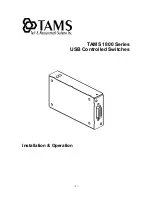
IDT sRIO Ports
Revision 1.5
Integrated Device Technology, Inc.
CPS-16/12/8 User Manual
2 - 6
July 10, 2012
2.2.3.1 Default Trace Routing Mode
In the default mode, the trace-enabled port accepts RapidIO traffic (referenced by the received packet’s
destination ID field) as well as traffic which matches the trace criteria of all ports. Trace-triggered packets
are treated by the trace-enabled output port in the same manner as it treats all other packets. Normal
RapidIO priority and flow control rules apply.
2.2.3.2 Optional Trace Routing Mode
In an optional mode, ONLY packets which have matched a port’s trace criteria are routed to the trace port.
For switch path, a received packet which does not match the Trace criteria, but whose destination ID field
references the Trace-enabled port is not forwarded to the trace port. If this packet has a destination ID that
references a multicast operation that includes the trace port, the packet is forwarded to all ports except for
the Trace-enabled port. However, packets from maintenance are still sent to the trace port even the packet
does not match trace criteria. Trace-triggered packets are treated by the trace-enabled output port in the
same manner as it treats all other packets. Normal RapidIO priority and flow control rules apply.
It is possible to configure the trace port into “trace only” mode and at the same time for the user to configure
a port’s route table to allow packets to be routed to the trace port (including packets which do not match the
trace criteria). With this configuration, packets received by a given port which are to be routed to the trace
port (as defined by that port’s route table) will be dropped by the device if they do not match the trace
criteria.
2.2.3.3 No Route Conditions
Packets which meet the trace criteria are routed to the trace port even if the packet destination ID reference
in the port’s route table indicates “no route”.
2.2.4 Trace Function Dynamic Programmability
By offering dynamic configurability, the CPS device provides the user with the ability to modify trace func-
tion parameters without disabling the normal operation of the port’s functionality.
The user is able to:
1) dynamically enable/disable the Trace function on a per-input port basis
2) dynamically assign the trace output port to any single output port
3) dynamically change the packet trace comparison values of any port
4) dynamically enable/disable any/all trace comparison values of any port
5) dynamically change the comparison value masks at any port
6) change a comparison value or mask (same value) for all ports with a write to a single address
2.2.5 Test feature for Trace Function
Each port provides a set of counters which increment each time the given port receives a packet that
matches the Trace criteria. Each port provides a counter for each of the four comparison values. These
counters are accessible in the same manner that all other device counters are made accessible. All trace
counters are 32-bits.
2.2.6 Flow Control with Trace Enabled
The CPS supports sRIO defined receiver flow control when Trace is enabled as well. If buffer contention
exists at the trace port such that a received packet which matches a port’s trace criteria would have to be
dropped (and therefore not be transmitted via the trace port) then the received packet is NACKed by the
port. If this condition exists the packet is not transmitted by any port regardless of its buffer condition. For
example, if the trace output port can’t receive additional packets because of buffer congestion, but there is
buffer space to support the normal (non-trace) path through the device, then the packet must be NACKed
and NOT transmitted via the normal route output port.
















































